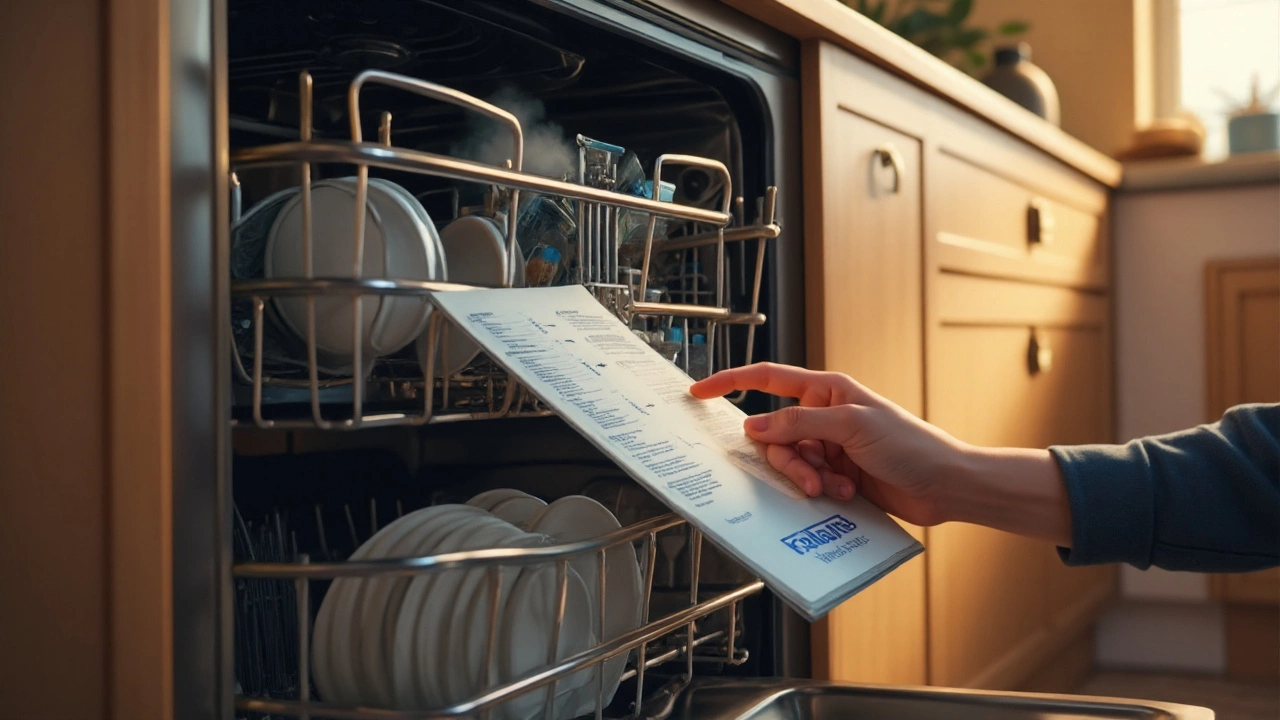Even the most reliable dishwashers can sometimes run into glitches, leaving dishes half-clean or the machine unresponsive. Fear not! Resetting your dishwasher could be the simple solution you need. Like rebooting a computer, a reset can clear minor system errors and bring your appliance back to life. But how precisely do you do it, and when is it the right approach?
In this article, we'll navigate the quirks and nuances of resets across different brands and models. We'll cover handy methods even your less tech-savvy cousin could pull off, ensuring you're not left wondering by the sink with soap on your hands. Ready to delve into the satisfying world of appliance troubleshooting? Let's get your dishwasher humming again.
- Recognizing When to Reset
- Manual Reset Methods
- Resetting Different Brand Models
- Troubleshooting Persistent Issues
- Preventive Maintenance Tips
Recognizing When to Reset
Before diving into the actions of resetting a dishwasher, it's crucial to discern whether a reset is genuinely needed. Appliance maintenance can often prevent bigger headaches, but knowing when to hit that reset button is an acquired skill.
Common Symptoms Indicating a Need for Reset
You might find your dishwasher acting out of character due to multiple reasons. For instance, an unexpected power surge could have scrambled its memory, leaving you with error codes flashing incessantly or controls that refuse to respond.
- Flashing Error Codes: If your dishwasher displays recurring error codes, a reset might help to clear these flashing lights—often signaling a sensor malfunction or software glitch.
- Unresponsive Control Panel: When you press the buttons and nothing happens, it's a strong indicator that a system reset could bring the controls back online.
- Incomplete Cycles: Should your appliance stop mid-cycle, leaving water pooling below your dishes, it may signal an internal error that a reset can resolve.
Modern Dishwasher Features
In the world of modern technology, manufacturers are innovating features to manage minor errors without manual interventions. Still, some hiccups require a human touch. Knowing how your specific model's tech works is instrumental.
Built-in Diagnostics
Today's machines often come equipped with diagnostic capabilities. These smart systems might attempt to fix themselves by running internal checks. However, suppose you notice the system diagnostics running but no changes occur. In that case, a manual reset could be the quickest route to normalcy.
According to a recent survey, about 40% of dishwasher owners encounter minor issues that could promptly be fixed with a reset, saving an estimated 40 minutes per troubleshooting session.
When Not to Reset
On the flip side, resetting isn't the panacea for every dishwasher woe. Persistent leaks, unusual noise, or complete power failures often indicate hardware failures that need professional repair beyond a simple reset.
Understanding the fine line between what a reset can fix and what requires deeper intervention protects you from wasted time and further complications. Recognizing symptoms and knowing your model can help you become a savant in dishwasher repair, standing proudly over a machine that faithfully churns out sparkling clean dishes.
Manual Reset Methods
When your dishwasher appears haunted or stubbornly refuses to do its job, a manual reset might just be the exorcism it needs. Resetting the appliance manually can often solve minor glitches caused by power anomalies or software gremlins, and the process varies subtly between different dishwasher models.
Basic Unplugging Method
The most rudimentary method, akin to a techie swear word, is the good old unplugging trick. This universal approach involves physically disconnecting your dishwasher from the power supply, allowing the internal electronics to reset. Here’s a step-by-step guide:
- Locate the power cord of your dishwasher. This might mean a little peek behind your under-counter device.
- Unplug the power cable from the outlet. If it is hardwired, turn off the dishwasher's circuit breaker in your home’s main electrical panel.
- Wait for at least 5 to 10 minutes. This time allows capacitors within the appliance to discharge and ensures a full reset.
- Plug the power back in or turn the circuit breaker back on.
- Run a test cycle without dishes to ensure the issue is resolved.
Control Panel Reset
Some modern dishwashers come equipped with a control panel sequence that can reset the system without needing a physical disconnect. Here's how:
- Open the dishwasher door to reveal the control panel.
- Identify the reset sequence for your specific model (often found in the user manual or online support). It could be as simple as pressing the "Start" button for 3 seconds or a combination of buttons like "Heated Dry" and "Normal Wash" pressed alternately.
- Follow the sequence precisely as described, then close the door to initiate a reset.
- Observe if the lights flash or the machine beeps, indicating the reset was successful.
These methods not only save you from unnecessary frustrations but also from potentially costly service calls, bringing your kitchen companion quickly back to life.
Extra Tip: The Fuse Box Friend
If your dishwasher resists, it may need a thorough power cycle involving the fuse box. Locate your home's electrical panel, switch off the dishwasher's fuse, wait a few minutes, and switch it back on. This cuts power completely, ensuring a more intensive reset.
If these techniques fail to resolve the underlying issue, it might induce a more in-depth inspection or professional assistance. However, starting with a manual reset is an effective first step in diagnosing your dishwasher's woes.

Resetting Different Brand Models
Every dishwasher is unique in its ways, much like the brands to which they belong. Whether it's because of differing technology or just a sprinkle of proprietary flair, knowing how to reset a dishwasher accurately requires knowing your brand. Here’s a breakdown of some popular models and their reset procedures to get you back in business without breaking a sweat.
Resetting Bosch Dishwashers
Bosch dishwashers are renowned for their efficiency and clever design, but they too can hit a snag. To reset a Bosch model, look for the Start button. Press and hold it for about 3-5 seconds. This action should clear any immediate errors. If your model is equipped with a display, it will often show a '0' or 'End' when the reset is successful.
Troubleshooting GE Dishwashers
GE's smart systems might occasionally get too smart for their own good. For most GE models, unplugging the unit for a brief moment (about 30 seconds) can do the trick. For hardwired models where unplugging isn't feasible, locate your kitchen’s circuit breaker and turn the power off then back on. It's the electrical equivalent of a deep breath for your dishwasher’s systems.
Samsung Models Mystery Solved
Modern Samsung dishwashers often come armed with digital diagnostics. A simple way to reset these is to press and hold the Start/Reset button for roughly 3 seconds. A standard chime indicates the process has taken effect. For models with touch panels, ensure your hands are dry to register the command effectively.
LG Dishwasher Recalibration
LG’s smart dishwashers often require a special touch. If your dishwasher isn't operating correctly, try the 'Cancel & Drain' method by pressing those respective buttons on the control panel. Follow it up by powering the unit down completely for 10 seconds. Upon restart, the system refreshes, eagerly ready to tackle your dish pile.
Maytag's Manual Reset Method
For owners of steadfast Maytag dishwashers, solving a glitch can be manual labor: open the dishwasher door and press control buttons in sequence listed on the manual—typically ranging from ‘normal’ + ‘heated dry’ in alternating presses. This series usually clears the error code or resets the electronic panel.
It’s often the little things that make our lives easier. If your dishwasher model isn’t mentioned here, your best recourse is to consult the owner’s manual or the brand’s support website. By doing so, you step out of guesswork and align perfectly with the manufacturer’s designed solution—just another step in proactive dishwasher troubleshooting.
Troubleshooting Persistent Issues
You've hit the reset button, unplugged and replugged, and the dishwasher is still acting up. Persistent issues can be a real headache, but they can often be tackled with some detective work and a bit of elbow grease. Let's investigate what might be plaguing your dishwasher and how to remedy it.
Common Persistent Problems
Some common issues that persist even after a reset include: incomplete drainage, strange noises, and unresolved error codes. These symptoms can be signals of underlying problems requiring a closer look.
Inadequate Drainage
If your dishwasher isn't draining properly, check for blockages in the drain hose or filter. Accumulated debris can hinder water flow, leading to those dreaded pool-of-water situations. Start by inspecting and cleaning these areas.
- Disconnect the dishwasher and remove the lower rack.
- Locate the filter and unscrew it carefully.
- Clean the filter under running water, scrubbing gently.
- Check the drain hose for kinks or blockages and clear them if found.
Mysterious Noises
Noises like grinding or humming can be unsettling. Often, they are caused by foreign objects – often tiny bones, bits of glass, or food – stuck in the machinery, or from an unbalanced machine.
- Turn off and unplug the dishwasher.
- Open the appliance and remove any visible debris.
- Ensure that the spray arms move freely and are not obstructed.
- Check if the dishwasher is sitting level; use a spirit level to adjust the feet accordingly.
Error Codes That Don't Disappear
Some error codes are stubborn and reset-resistant. Each brand has its own set of codes; for instance, a persistent E15 on a Bosch could mean a water leakage. Consulting the manual for specific meanings can provide clarity. Here is how to tackle these codes effectively:
- Look up the specific error code in the manual or the manufacturer's website.
- If it's a minor issue, you might be able to resolve it yourself. Otherwise, note down all error information before contacting support.
- Frequently, disconnection from power for a longer duration (10-15 minutes) can help reset stubborn electronics if not a physical issue.
When to Call in the Pros
If troubleshooting persistent issues on your own isn't yielding results, it might be time to call in an expert. Regular service checks can prevent small issues from escalating into major repairs.
Did you know that approximately 20% of dishwasher repairs are due to neglected maintenance? Regular check-ups can save you from costly repairs down the road.
Understanding how to tackle persistent dishwasher issues not only salvages sanity but prolongs appliance lifespan. Becoming a bit of a dishwasher whisperer ensures those dirty dishes don't pile up ever again!

Preventive Maintenance Tips
To keep your dishwasher from needing frequent resets, regular maintenance is key. Routine check-ups can prevent many of the common issues that lead to malfunctions and can help ensure your appliance runs smoothly for years to come.
Regular Cleaning
The cleanliness of your dishwasher's interior plays a crucial role in its performance. Sediment and debris often build up over time, which can cause clogs and affect washing efficiency. To prevent this, aim to clean the filter at least once a month. Remove the lower dish rack, locate the filter at the bottom, and rinse it under warm water to remove food particles.
Inspecting Seals and Gaskets
Dishwasher door seals and gaskets can deteriorate or become misaligned, leading to leaks. Regularly inspect these rubber components for wear and tear. If you spot any damage or if they feel brittle, replace them promptly. This simple check can prevent water from leaking, which can cause more significant problems with the appliance over time.
Avoid Overloading
It might be tempting to cram as many dishes as possible into a single cycle to save time and water. However, overloading the dishwasher can impede its ability to clean effectively and strain the internal components. Make sure there's enough space between items for water and detergent to circulate properly. This ensures optimal cleaning and reduces wear on the machine's parts.
Appropriate Detergent Use
Using the right detergent is as crucial as the cleaning cycle itself. Always use a detergent compatible with your dishwasher model. Check the manual for recommendations. Also, be mindful of the amount used—too much detergent can result in residue buildup, while too little may leave your dishes unsanitary.
Sample Maintenance Schedule
| Task | Frequency |
|---|---|
| Clean filter | Monthly |
| Inspect seals | Quarterly |
| Check spray arms | Bimonthly |
| Run hot water cycle with vinegar | Every 6 months |
By following these maintenance tips, the occasional need to reset the dishwasher becomes less of a burden, keeping your appliance running efficiently and reducing the likelihood of unexpected breakdowns.

